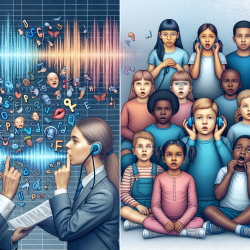Speech therapy practitioners constantly seek effective methods to remediate speech production errors, particularly in children with functional articulation disorders. A groundbreaking study, "Remediating Speech Production Errors with Sound Identification Training," sheds light on an innovative approach that could significantly impact therapeutic strategies. This blog post explores the key findings of the research and how practitioners can implement or further research these outcomes to enhance their therapeutic practices.
Traditional speech therapy often emphasizes direct articulation training and auditory discrimination exercises. However, the study by Donald G. Jamieson and Susan Rvachew introduces a novel concept: leveraging speech perception training to improve speech production. The research focused on children with functional articulation disorders, who also exhibited speech perception difficulties, and used a modified fading technique to teach sound identification.
Key Findings:
- Speech perception training significantly improved speech production in children who exhibited both production and perception difficulties.
- The modified fading technique involved teaching children to identify synthetically produced fricatives, enhancing their ability to distinguish between the target sound and the substitution error in their speech.
- Improvements were observed rapidly, suggesting that perception training can be an effective component of speech therapy for specific subgroups of children.
The implications of these findings are profound for speech therapy practitioners. By incorporating speech perception training into therapy programs, therapists can address the perceptual aspects of articulation disorders, potentially leading to more efficient and effective remediation of speech production errors.
Implementing the Research:
To apply these findings in clinical practice, therapists can consider the following steps:
- Assessment: Evaluate both speech production and perception abilities in children with articulation disorders. This will help identify candidates who may benefit most from perception training.
- Training Program: Develop a training program that includes sound identification tasks using synthetic stimuli, gradually increasing in difficulty as the child improves.
- Monitoring Progress: Use pre- and post-treatment assessments to monitor changes in speech production and perception, adjusting the program as needed based on the child's progress.
For practitioners interested in exploring this approach further, conducting additional research could also be beneficial. Investigating the long-term effects of perception training, its applicability to other types of speech sound disorders, and how it can be integrated with traditional speech therapy techniques are all areas ripe for exploration.
In conclusion, the study by Jamieson and Rvachew opens up new avenues for enhancing speech therapy through the inclusion of speech perception training. By carefully selecting candidates and designing targeted training programs, therapists can leverage these insights to improve outcomes for children with articulation disorders.
For those interested in delving deeper into the research and its methodology, the original study provides a comprehensive overview of the sound identification training procedure and its effects on speech production. Remediating Speech Production Errors with Sound Identification Training.










